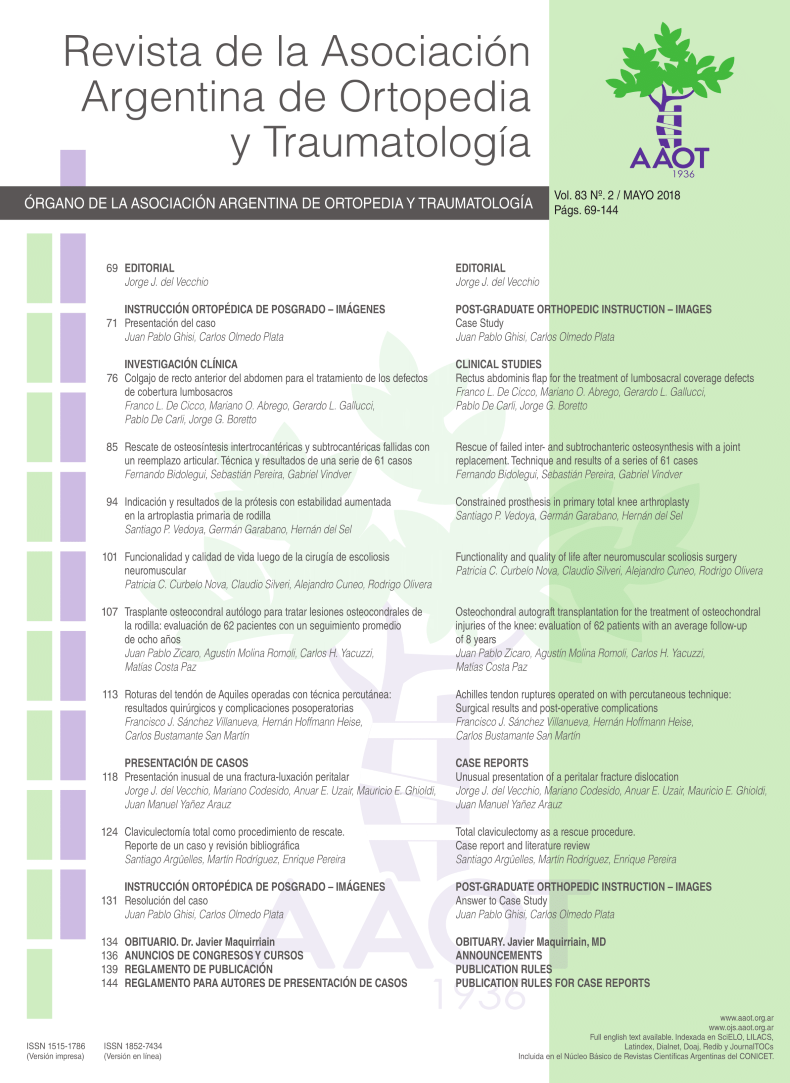Roturas del tendón de Aquiles operadas con técnica percutánea: resultados quirúrgicos y complicaciones posoperatorias. [Achilles tendon ruptures operated on with percutaneous technique: surgical results and post-operative complications.]
Contenido principal del artículo
Resumen
Descargas
Métricas
Detalles del artículo

Esta obra está bajo licencia internacional Creative Commons Reconocimiento-NoComercial-CompartirIgual 4.0.
La aceptación del manuscrito por parte de la revista implica la no presentación simultánea a otras revistas u órganos editoriales. La RAAOT se encuentra bajo la licencia Creative Commons 4.0. Atribución-NoComercial-CompartirIgual (http://creativecommons.org/licenses/by-nc-sa/4.0/deed.es). Se puede compartir, copiar, distribuir, alterar, transformar, generar una obra derivada, ejecutar y comunicar públicamente la obra, siempre que: a) se cite la autoría y la fuente original de su publicación (revista, editorial y URL de la obra); b) no se usen para fines comerciales; c) se mantengan los mismos términos de la licencia.
En caso de que el manuscrito sea aprobado para su próxima publicación, los autores conservan los derechos de autor y cederán a la revista los derechos de la publicación, edición, reproducción, distribución, exhibición y comunicación a nivel nacional e internacional en las diferentes bases de datos, repositorios y portales.
Se deja constancia que el referido artículo es inédito y que no está en espera de impresión en alguna otra publicación nacional o extranjera.
Por la presente, acepta/n las modificaciones que sean necesarias, sugeridas en la revisión por los pares (referato), para adaptar el trabajo al estilo y modalidad de publicación de la Revista.
Citas
2. Chen T, Rozen W, Pan WR, Ashton M, Richardson M, Taylor G. The arterial anatomy of the Achilles tendon: Anatomical study and clinical implications. Clin Anat. 2009;22:377-385.
3. Gross C, Nunley J. Acute Achilles Tendon Ruptures. Foot Ankle Int. 2016 Feb;37:233-9.
4. Lantto I, Heikkinen J, Flinkkilä T, Ohtonen P, Leppilahti J. Epidemiology of Achiles tendón ruptures: increasing incidence over a 33-year period. Scand J Med Sci Sports. 2015 Feb;25:133-8.
5. Houshian S, Tscherning T, Riegels-Nielsen P. The epidemiology of Achilles tendon rupture in a Danish county. Injury.1998;29:651-654.
6. Amlang M, Christiani P, Heinz P, Zwipp H. Percutaneous technique for Achilles tendon repair with the Dresden Instruments. Unfallchirurg. 2005;108:529–536.
7. Moller A, Astrom M, Westlin N. Increasing incidence of Achilles tendon rupture. Acta Orthop Scand. 1996;67:479–481.
8. Suchak A, Bostick G, Reid D, Blitz S, Jomha N. The incidence of Achilles tendon ruptures in Edmonton, Canada. Foot Ankle Int. 2005;26:932–936.
9. Inglis A, Sculco T. Surgical repair of ruptures of the tendón Achillis. Clin Orthop Relat Res. 1981;156:160-169.
10. Ufberg J, Harrigan R, Cruz T, Perron A. Orthopedic pitfalls in the ED: Achilles tendon rupture. Am J Emerg Med.2004;22:596-600.
11. Cuttica D, Hyer C, Berlet G. Intraoperative value of the Thompson test. J Foot Ankle Surg. 2015 Jan-Feb;54:99-101.
12. Chiodo C, Glazebrook M, Bluman E, Cohen B, Femino J, Giza E, et al. Diagnosis and treatment of acute Achilles tendon rupture. J Am Acad Orthop Surg. 2010;18:503-510.
13. Kocher M, Bishop J, Marshall R, Briggs K, Hawkins R. Operative versus nonoperative management of acute Achilles tendon rupture: expected-value decision analysis. Am J Sports Med. 2002;30:783–790.
14. Maffulli N. Current Concepts Review: Rupture of the Achilles tendon. J Bone Joint Surg Am. 1999;81:1019–1036.
15. Wong J, Barrass V, Maffulli N. Quantitative review of operative and nonoperative management of Achilles tendón ruptures. Am J Sports Med. 2002;30:565–575.
16. Kadakia AR, Dekker RG, Ho BS. Acute Achilles Tendon Ruptures: An Update on Treatment. J Am Acad Orthop Surg. 2017 Jan;25:23-31.
17. Nilsson-Helander K, Silbernagel KG, Thomeé R, Faxen R, Olsson N, Eriksson BI, et al. Acute Achilles tendon rupture: A randomized, controlled study comparing surgical and nonsurgical treatments using validated outcome measures. Am J Sports Med 2010;38: 2186-2193.
18. Wallace RG, Heyes GJ, Michael AL: The non-operative functional management of patients with a rupture of the tendo Achillis leads to low rates of re-rupture. J Bone Joint Surg Br 2011;93:1362-1366.
19. Born C, Gil JA, Goodman A. Joint Contractures Resulting From Prolonged Inmovilization: Etiology, Prevention and Management. J Am Acad Orthop Surg. 2017 Feb;25:110-116.
20. Winter E, Weise K, Weller S, Ambacher T. Surgical repair of Achilles tendon rupture: comparison of surgical with conservative treatment. Arch Orthop Trauma Surg. 1998;117:364–367.
21. Truntzer, J, Triana B, Harris A, Baker L, Chou L, Kamal R. Cost-minimization Analysis of the Management of Acute Achilles Tendon Rupture. J Am Acad Orthop Surg. 2017 Jun;25:449-457.
22. Henríquez H, Muñoz R, Carcuro G, Bastías C. Is Percutaneous Repair Better Than Open Repair in Acute Achilles Tendon Rupture?. Clin Orthop Relat Res. 2012 Apr;470:998-1003.
23. Gigante A, Moschini A, Verdenelli A, Del Torto M, Ulisse S, de Palma L. Open versus percutaneous repair in the treatment of acute Achilles tendon rupture: a randomized prospective study. Knee Surg Sports Traumatol Arthrosc. 2008;16:204–209.

